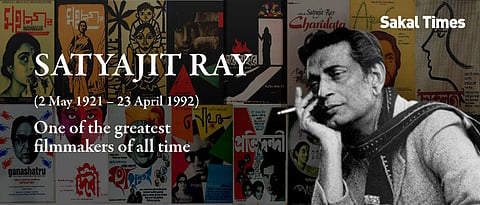

Satyajit Ray, a name associated with revolutionising Indian cinema, has created many extraordinary masterpieces of cinematic beauty. Born in a Bengali family, prominently known for their contributions to art and literature, young Ray was naturally inclined towards writing and storytelling since early childhood. Ray is celebrated worldwide as a renowned motion-picture director, writer, and illustrator and also regarded as one of the greatest filmmakers of all time. On his 99th birth anniversary, let’s take a look at his cinematic journey.
Satyajit Ray’s Directorial Debut: PatherPanchali (1955; Song of the Little Road)
Ray began his journeyas a director with the film Pather Panchali, an adaptation of Bibhutibhushan Bandyopadhyay’s novel of the same title, published in 1929. The film portrays life a young boy named Apu who lives in poverty in a small village. Ray goes on to capture Apu’s journey in a trilogy, reflecting his childhood to manhood from a small village to the city of Calcutta.
For many of the films, Ray drew inspiration from Italian neorealism, a national film movement in Italian cinema which used to portray the struggles of working-class and poor people, frequently using non-professional actors, shot on location. Such films were used as a tool to give a social message. Ray was specifically inspired by the success of Vittorio De Sica’s The Bicycle Thief (1948; Ladri di biciclette) and used a similar narrative style of the realistic world in the film, Pather Panchali.
When Ray wanted to experiment with this new style of filmmaking, he suffered a lot of obstacles. The Bengali producers at the time being sceptical about this and distrusted him for his unconventional ideas. Ray started the film’s shooting in 1952 using his own money and later got some help from the government of West Bengal. It took two-and-a-half years to complete the film as most of the crew lacked experience and worked unpaid. Finally, in 1955, Pather Panchali was completed and was a tremendous success in India as well as in the West. It also received an award at the Cannes International Film Festival (1956).
REVOLUTIONARY CHANGE IN INDIAN CINEMA
Indian cinema had gained worldwide recognition due to Pather Panchali (1955; Song of the Little Road). This was a golden opportunity for the filmmaker to work on this different style of filmmaking. As mentioned earlier, he worked on two sequels after Pather Panchali, known as ‘The Apu Trilogy’ consisting of films, Aparajito (1956; The Unvanquished) and Apur Sansar (1959; The World of Apu). Both of them received praise and appreciation by the audience and critics for its art and aesthetics.
Satyajit Ray created many masterpieces after The Apu Trilogy. The films like Mahanagar: The Big City (1963), Devi (1960), Teen Kanya (1961), Charulata (1964) or films based on novels or other works by Rabindranath Tagore, Charulata (1964; The Lonely Wife), Teen Kanya (1961; Three Daughters, English-language title Two Daughters), to name a few, can only give us a glimpse into the cinematic treasure. His films were real, subtle and thought-provoking. Every film was crafted with in-depth research and control over all its elements. Music was also one of the important tools used to set the natural yet dramatic tone in Ray’s films.The depictions of humanism, culture and even concepts like neorealism were never shown in Indian cinema with such efficiency before.
TRIBUTE TO THE LEGENDARY FILMMAKER OF INDIAN CINEMA
Ray has been a recipient of India’s highest award in cinema, the Dadasaheb Phalke Award (1984) and India's highest civilian award, the Bharat Ratna (1992). He was received prestigious awards and honours, including awarded the Commander of the National Order of the Legion of Honour, the highest decoration in France (1987) and an Honorary Award at the 64th Academy Awards (1991).
